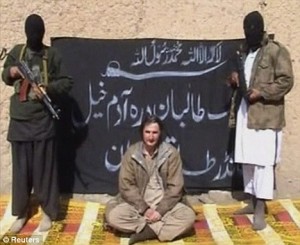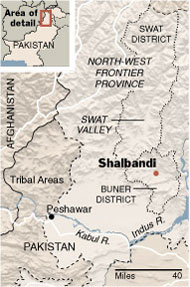A confluence of events and articles is focusing attention on the question(s) “Why are we in Afghanistan?” and “Is it worth it?” A main stream media reporter recently sent The Captain’s Journal a note questioning what would happen if the U.S. and Britain completely pulled out of Afghanistan? This reporter isn’t alone. The likes of Dr. John Nagl, Michael Yon, Bill Roggio and Dr. David Kilcullen have recently weighed in on a number of both directly and tangentially related issues concerning whether we stay in Afghanistan and what the campaign should look like if we do. Since this also relates to our own advocacy of a particular strategy for Afghanistan, we’ll take a sweeping trek across this terrain.
David Kilcullen weighs in at The Small Wars Journal Blog with Crunch Time in Afghanistan-Pakistan (an edited version of his statement before the Senate Foreign Relations Committee hearing on Afghanistan, 5th February 2009). We’ll return to what Kilcullen says shortly, but first, there is a particular comment that runs in the same vein as the many of the objections to the campaign. Excerpts are provided below.
… is it not better to cut the losses and leave now? What is the downside of an immediate departure? Loss of prestige? We have none to lose with any the groups we’re attempting to defeat. Loss of deterrence? As Israel will discover, misapplied force encourages rather than discourages resistance. (Didn’t some guy named Galula say that about 50 years ago?) The Taliban take over? Let them. As with Hamas, the only avenue to a positive outcome for us is to let them attempt to govern. If they succeed and create development and stability, we win. If they fail and destroy their popular support, we win … That al Qaeda will flourish? It’s more an identity than an entity, and we can’t defeat ideas with firepower. External events will determine al Qaeda’s viability. The instability in Afghanistan spills over into Pakistan? Too late. We pretty much assured that when we underwrote the original mujahedeen back in the 80’s and then walked away after the Red Army bolted … That heroin will flood the world? Legalize drugs and kill their funding source. (And that of the cartels.) (And we can shift the DEA budget to development work.) That it will become a training ground (again) for terrorists? As long as there is a sea of disaffected people for them to swim in, terrorists will exist and their camps will be somewhere. True counterterrorism is social work – police, intel, development. The solution is social justice, not combat … Aid workers are a lot cheaper than warfighters, and the rising expectation of Pashtuns, driven by the awareness of their neighbors’ prosperity, will become an existential threat to the Taliban.
This objection to the campaign as it is currently constituted is the classic counterterrorism schema in which kinetic operations are reserved for high value targets and the population is changed from policing actions and social justice. Seth G. Jones with RAND is a proponent of this model, i.e., that policing and intelligence are the answer to the problem rather than military action.
Aid workers would suffer the same fate as the Polish engineer who was recently executed by the Taliban.

When aid workers have no security they cannot perform the functions of an aid worker. The Taliban will hardly create a stable regime, and Afghanistan would indeed become a haven again for AQ. Furthermore, the mission of the Taliban (both Afghan Taliban and Tehrik-i-Taliban) is harmonizing into one of support for regional control and then confrontation of the West. Baitullah Mehsud has made it clear that the goals of the TTP have evolved to one of global aspirations: “We want to eradicate Britain and America, and to shatter the arrogance and tyranny of the infidels. We pray that Allah will enable us to destroy the White House, New York, and London.”
If the Taliban ever were just local rogues and thugs who wanted control over money and women, they aren’t now only that. There has been a dovetailing not only of ideology but of forces as well. The Tehrik-i-Taliban shout to passersby in Khyber “We are Taliban! We are mujahedin! “We are al-Qaida!” There is no distinction. Bill Roggio has recently written about al Qaeda’s shadow army, operating in both Pakistan and Afghanistan.
Al Qaeda has reorganized its notorious paramilitary formations that were devastated during the US invasion of Afghanistan in 2001 and 2002. Al Qaeda has reestablished the predominantly Arab and Asian paramilitary formation that was formerly known as Brigade 055 into a larger, more effective fighting unit known as the Lashkar al Zil, or Shadow Army, a senior US intelligence official told The Long War Journal.
The Shadow Army is active primarily in Pakistan’s tribal areas, the Northwest Frontier Province, and in eastern and southern Afghanistan, several US military and intelligence officials told The Long War Journal on condition of anonymity due to the sensitivity of the subject.
The paramilitary force is well trained and equipped, and has successfully defeated the Pakistani Army in multiple engagements. Inside Pakistan, the Shadow Army has been active in successful Taliban campaigns in North and South Waziristan, Bajaur, Peshawar, Khyber, and Swat.
In Afghanistan, the Shadow Army has conducted operations against Coalition and Afghan forces in Kunar, Nuristan, Nangahar, Kabul, Logar, Wardak, Khost, Paktika, Paktia, Zabul, Ghazni, and Kandahar provinces.
“The Shadow Army has been instrumental in the Taliban’s consolidation of power in Pakistan’s tribal areas and in the Northwest Frontier Province,” a senior intelligence official said. “They are also behind the Taliban’s successes in eastern and southern Afghanistan. They are helping to pinch Kabul.”
Afghan and Pakistan-based Taliban forces have integrated elements of their forces into the Shadow Army, “especially the Tehrik-e-Taliban and Haqqani Network,” a senior US military intelligence official said. “It is considered a status symbol” for groups to be a part of the Shadow Army.
There are no “reconcilables” in this group or the TTP. The time delay in conducting legitimate counterinsurgency in Afghanistan has ensured that the Taliban have become radicalized.
Michael Yon has penned a sober (and sobering) analysis of the situation in Afghanistan.
The Iraq war, even during the worst times, never seemed like such a bog. Yet there is something about our commitment in Afghanistan that feels wrong, as if a bear trap is hidden under the sand … We must also understand that Afghanistan is what it is. The military is acutely aware that Afghanistan is not Iraq. The success we are seeing in Iraq is unlikely to suddenly occur in Afghanistan. If we are to deal with moderate elements of the AOGs (armed opposition groups) we must do so from a position of strength, and this means killing a lot of them this year, to encourage the surviving “reconcilables” to be more reconcilable.
In fact, Dr. John Nagl waxes even darker in his forecast.
Col Nagl, an Iraq veteran who helped devise the successful strategy there under the aegis of Gen David Petraeus, told The Daily Telegraph that the gains made by the Taliban over the past two years need to be reversed by the end of the traditional fighting season in Afghanistan, around late September or early October, or else the Taliban will establish a durable base that would make a sustained Western military presence futile.
The forecast given by The Captain’s Journal to the querry from the MSM journalist was fundamentally that without U.S. and British troops in Afghanistan, the Taliban would be inside of Kabul within two weeks and the Karzai regime would collapse within one month to six weeks. The Afghan police would be slaughtered, and the Army would last just a little longer than the police. The Northern Alliance (which has been relegated to the sidelines by the U.S., and supported to some extent by India) would then be at civil war again with the Taliban. Al Qaeda and a radicalized Taliban (such as the TTP) along with other international jihadist elements would have safe haven from which to train and launch attacks against Pakistan initially, and the West eventually.
To return to what Kilcullen advocates, he advises against the notion of a scaled-back effort performing counterterrorism operations against al Qaeda. Whether we like it or not, we must provide security for the population and rebuild government legitimacy. He also contrasts “chasing the Taliban around” with providing security, a dichotomy The Captain’s Journal rejects. Having enough troops to chase and kill the Taliban should be part of an effective counterinsurgency strategy. Petraeus has said so himself.
But Kilcullen is fundamentally right. Counterinsurgency is the only viable option, short of pulling out of Afghanistan come what may. Counterterrorism-policing operations against high value targets has failed us for six years in Afghanistan, and engaging only the soft side of COIN (i.e., sending more aid workers to rebuild the nation as the military bolted from the country) is a bizarre strategy to say the least. As for Pakistan? Again, listen to one Taliban who, when interviewed, gave away valuable intelligence concerning their perspective. “If NATO remains strong in Afghanistan, it will put pressure on Pakistan. If NATO remains weaker in Afghanistan, it will dare [encourage] Pakistan to support the Taliban, its only real allies in the region.”
Afghanistan is as good a place to begin the regional counterinsurgency campaign as anywhere.





